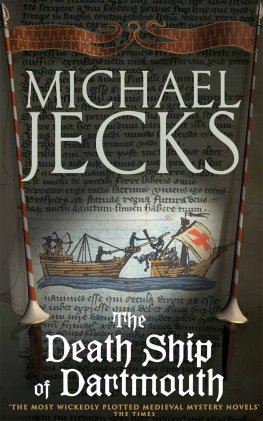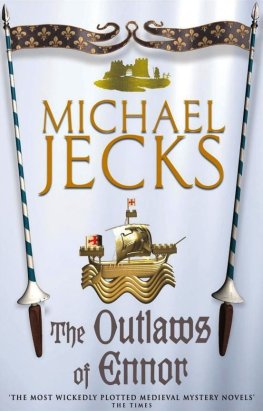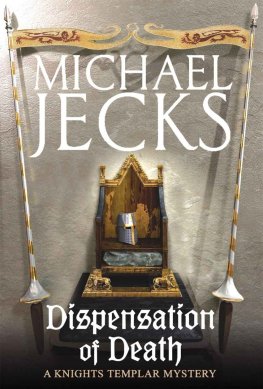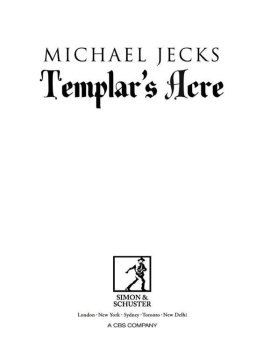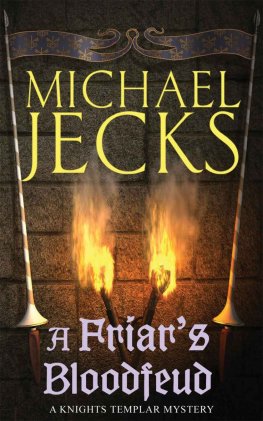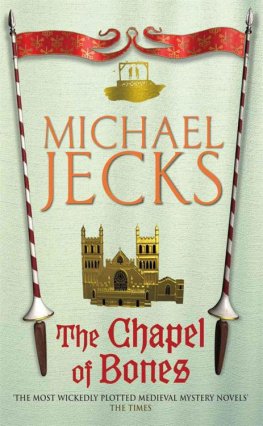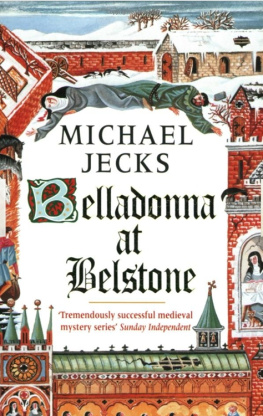Michael Jecks
THE STICKLEPATH STRANGLER
2001
This book is for Shirley and Dartmoor Dave Denford, the blacksmith who dont do orses.
This book is a work of fiction. Names, characters, places and incidents are either a product of the authors imagination or are used fictitiously. Any resemblance to actual people, living or dead, events or locales, is entirely coincidental.
Sir Baldwin de Furnshill
The Keeper of the Kings Peace in Crediton, Baldwin has been marked by the injustice of the destruction of the Knights Templar. As a result he seeks justice for common folk.
Lady Jeanne
Baldwins wife, who was once widowed and now fears losing her second husband.
Edgar
Baldwin saved Edgars life in Acre, and since then Edgar swore loyalty to him for life. He is Baldwins most trusted servant.
Simon Puttock
Long a friend of Baldwins, and an official of the Stannaries, the tin miners of Dartmoor. Simon and Baldwin have often worked together on investigations.
Roger de Gidleigh
Coroner Roger is one of only two Coroners who must investigate all sudden deaths and wrecks in Devonshire.
Nicole Garde
The French wife of Thomas Garde; mother of Joan.
Thomas Garde
Thomas is a freeman, who works his own little plots, but he is an incomer to the vill of Sticklepath and has never been fully accepted.
Joan
Daughter of Nicole and Thomas, Joan has found a corpse.
Ivo Bel
Brother of Thomas, and Manciple to the nuns of Canonsleigh. He lusts after Nicole, his sister-in-law.
Serlo Warrener
A gruff, hardy man, crippled years ago, who tends to the warren up on the moor.
Athelhard
Athelhard was killed by the vill when they thought him guilty of murder.
Mad Meg
Sister to Athelhard, and simple from birth, Meg avoids the vill since the death of her brother.
Ansel de Hocsenham
A Purveyor to the King, Ansel last visited the vill during the 131516 famine.
Emma
Close friend of Joan who found the corpse with her.
Swetricus
A peasant of Sticklepath who lost Aline, his daughter, several years ago. Three daughters survive.
Samson atte Mill
The miller, known for brawling and drunkenness.
Gunilda
Samsons wife, a downtrodden woman.
Felicia
Samson and Gunildas daughter.
Alexander de Belston
The cautious Reeve of Sticklepath who is determined to preserve the reputation of the vill and its people.
William Taverner
William is the master of the only inn.
Ham
Taverners son, who was killed in the recent floods.
Mary
Daughter to Taverner, who often serves visitors to the inn.
Gervase Colbrook
Parson to the little chantry chapel of Sticklepath.
Drogo le Criur
Leader of the Foresters, charged with the duty of guarding the Forest of Dartmoor and travellers over it.
Peter atte Moor
A Forester under Drogo, Peter lost his daughter Denise to the murderer some years ago.
Adam Thorne
Also a Forester, Adam has a bad limp, but is known for his strength and integrity.
Vincent Yunghe
The youngest of the Foresters, Vin is still learning his duties.
Miles Houndestail
A traveller who was first to see the corpse with the two girls.
There is a natural series of stages in the creation of a new book. For me, a central scene comes first, something which drives the whole of the rest of the story. In The Lepers Return, for instance, I wanted to look at leprosy in the Middle Ages, while in The Crediton Killings, I examined the role of mercenaries. Often, though, I find myself chewing over a curious beginning and wondering how I could develop it into a story. The Sticklepath Strangler belongs to this category, and I have to thank Deryn Lake, author of the excellent John Rawlings stories, for the initial idea.
It was while we were walking over Dartmoor not, I have to add, the sort of thing that Deryns friends would expect of her some few years ago that she and I swapped ideas for new novels.
My idea for her was for a deserted ship suddenly arriving at a Devon port, a concept she used in her novel Death in the Port of Exeter, while hers gave me the initial scene of this book, with Joan and Emmas hideous discovery. I must add that her suggestion that I should write about a skull falling from a wall came only from an appreciation of a two-thousand-year-old wall not from any wishful thinking about what she would like to do with the struggling author who had promised to show her an attractive walk to a not-too-far distant pub.
And if Michael, who later gave us a lift back from the Northmore Arms in his Audi, should ever read this, I would like to thank him too.
Sticklepath is a fairly typical and relatively unspoilt village, but it has had a confusing past.
Take the Church: Sticklepath has been split among the parishes of Sampford Courtenay, South Tawton and Belstone. Then again the roads have all changed their routes; the main road used to suffer gridlock for the whole of the summer until the dual carriageway was built, which avoids Whiddon Down, South Zeal, Sticklepath, and Okehampton itself, so that now, instead of stationary vehicles belching fumes on the old A30, locals have no passing traffic whatever. Good for the children walking to and from school, but less so for the many pubs and cafes which were built on the old road. Most have been forced to close.
Sticklepath itself has had a great history. There is the Finch Foundry, until the 1960s a working tool-manufacturer which exported its billhooks and spades all over the world. Nowadays the foundry is a National Trust museum dedicated to water power, and I would recommend anyone who has an interest in metalwork and smithing to visit it, especially since Dartmoor Dave Denford, to whom this book is dedicated, can often be found there giving demonstrations of blacksmithing. Just remember not to ask if he makes horseshoes. He is keen to point out that I dont do orses, since he is not a farrier. Yes, there is a difference.
A short way further up the river from the foundrys water-wheels is the old mill of Tom Pearce, made famous in the song Widecombe Fair. Now the main buildings have gone, to be replaced by houses. The mill too has been converted, but not so long ago, a thick serge-type of cloth was still being manufactured here from wool shorn from the sheep on Dartmoor; it was then worn all over the British Empire by soldiers and sailors alike. All this from a tiny little village hiding in a valley in the middle of Devonshire.
The success of the place came from two factors: its abundant water power, and its location on the main road to Cornwall. The village supplied the needs of visitors and travellers, because during the age of horse travel, everyone going to Cornwall passed through Sticklepath and made use of its inns, cooks and grooms. While other villages lost their trade, like South Zeal, which was bypassed centuries ago so that the mail coach horses didnt have to cope with the two hills at either side of the town, Sticklepath somehow survived.
There was no bypass for the hilly part of the road which gave the Stickle or Steep path its name until fairly recently. In fact, there are many local families who can still remember grandparents talking about the time when the road went up the hill.


